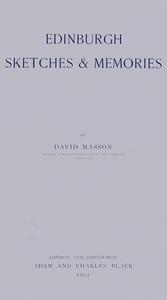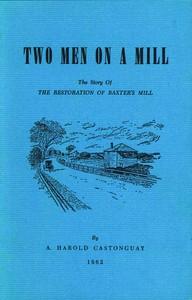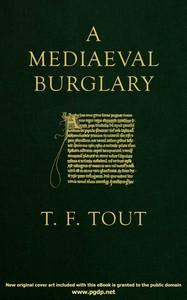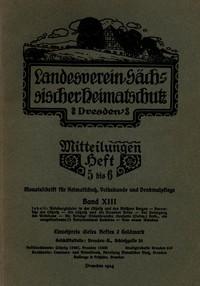|
|
Read this ebook for free! No credit card needed, absolutely nothing to pay.Words: 147473 in 17 pages
This is an ebook sharing website. You can read the uploaded ebooks for free here. No credit cards needed, nothing to pay. If you want to own a digital copy of the ebook, or want to read offline with your favorite ebook-reader, then you can choose to buy and download the ebook. QUEEN MARY'S EDINBURGH On a clear day the inhabitants of Edinburgh, by merely ascending the Calton Hill or any other of the familiar heights in or around their city, can have a view of nearly the whole length of their noble estuary, the Firth of Forth. To the right or east, its entrance from the open sea, between the two shires of Fife and Haddington, is marked most conspicuously on the Haddingtonshire side by a distant conical mound, called Berwick Law, rising with peculiar distinctness from the northward curve of land which there bounds the horizon. It is thither that the eye is directed if it would watch the first appearance of steamers and ships from any part of the world that may be bound up the Firth for Edinburgh by its port of Leith. Moving thence westward, the eye can command easily the twenty miles more of the Firth which these ships and steamers have to traverse. The outlines of both shores, though the breadth between them averages twelve miles, may be traced with wonderful sharpness, pleasingly defined as they are by their little bays and promontories, and by the succession of towns and fishing villages with which they are studded. Of these, Musselburgh on the near side marks the transition from the shire of Haddington to that of Edinburgh; after which point the Firth begins to narrow. Just below Edinburgh itself, where its port of Leith confronts the Fifeshire towns of Kinghorn and Burntisland, with the island of Inchkeith a little to the right between, the breadth is about six miles. There the main maritime interest of the Firth ceases, few ships going farther up; but, for any eye that can appreciate scenic beauty, there remains the delight of observing the continued course of the Firth westward to Queensferry and beyond, a riband of flashing water between the two coasts which are known prosaically as those of Linlithgowshire and West Fifeshire, but which, in their quiet and mystic remoteness, look like a tract of some Arthurian dreamland. She had left Calais for the homeward voyage on Thursday the 14th August, with a retinue of about 120 persons, French and Scottish, embarked in two French state galleys, attended by several transports. They were a goodly company, with rich and splendid baggage. The Queen's two most important uncles, indeed,--the great Francis de Lorraine, Duke of Guise, and his brother, Charles de Lorraine, the Cardinal,--were not on board. They, with the Duchess of Guise and other senior lords and ladies of the French Court, had bidden Mary farewell at Calais, after having accompanied her thither from Paris, and after the Cardinal had in vain tried to persuade her not to take her costly collection of pearls and other jewels with her, but to leave them in his keeping till it should be seen how she might fare among her Scottish subjects. But on board the Queen's own galley were three others of her Guise or Lorraine uncles,--the Duke d'Aumale, the Grand Prior, and the Marquis d'Elbeuf,--with M. Damville, son of the Constable of France, and a number of French gentlemen of lower rank, among whom one notes especially young Pierre de Bourdeilles, better known afterwards in literary history as Sieur de Brant?me, and a sprightly and poetic youth from Dauphin?, named Chastelard, one of the attendants of M. Damville. With these were mixed the Scottish contingent of the Queen's train, her four famous "Marys" included,--Mary Fleming, Mary Livingstone, Mary Seton, and Mary Beaton. They had been her playfellows and little maids of honour long ago in her Scottish childhood; they had accompanied her when she went abroad, and had lived with her ever since in France; and they were now returning with her, Scoto-Frenchwomen like herself, and all of about her own age, to share her new fortunes. The Leith people and the Edinburgh people were quite unprepared, the last intimation from France having pointed to the end of the month as the probable time of the Queen's arrival, if she were to be expected at all. But the cannon-shots from the galleys, as they contrived to near Leith harbour, were, doubtless, a sufficient advertisement. Soon, so far as the fog would permit, all Leith was in proper bustle, and all the political and civic dignitaries that chanced to be in Edinburgh were streaming to Leith. Not till the evening, according to one account, not till next morning, according to another, did the Queen leave her galley and set foot on shore. Then, to allow a few hours more for getting her Palace of Holyrood, and her escort thither, into tolerable readiness, she took some rest in the house in Leith deemed most suitable for her reception, the owner being Andrew Lamb, a wealthy Leith merchant. It was in the afternoon of Wednesday, the 20th of August, that there was the procession on horseback of the Queen, her French retinue, and the gathered Scottish lords and councillors, through the two miles of road which led from Leith to Holyrood. On the way the Queen was met by a deputation of the Edinburgh craftsmen and their apprentices, craving her royal pardon for the ringleaders in a recent riot, in which the Tolbooth had been broken open and the Magistrates insulted and defied. This act of grace accorded as a matter of course, the Queen was that evening in her hall of Holyrood, the most popular of sovereigns for the moment, her uncles and other chiefs of her escort with her, and the rest dispersed throughout the apartments, while outside, in spite of the fog, there were bonfires of joy in the streets and up the slopes of Arthur Seat, and a crowd of cheering loiterers moved about in the space between the palace-gate and the foot of the Canongate. Imparting some regulation to the proceedings of this crowd, for a while at least, was a special company of the most "honest" of the townsmen, "with instruments of musick and with musicians," admitted within the gate, and tendering the Queen their salutations, instrumental and vocal, under her chamber-window. "The melody, as she alledged, lyked her weill, and she willed the same to be continewed some nightis after." This is Knox's account; but Brant?me tells a different story. After noting the wretchedness of the hackneys provided for the procession from Leith to Holyrood, and the poorness of their harnessings and trappings, the sight of which, he says, made the Queen weep, he goes on to mention the evening serenade under the windows of Holyrood as the very completion of the day's disagreeables. The Abbey itself, he admits, was a fine enough building; but, just as the Queen had supped and wanted to go to sleep, "there came under her window five or six hundred rascals of the town to serenade her with vile fiddles and rebecks, such as they do not lack in that country, setting themselves to sing psalms, and singing so ill and in such bad accord that there could be nothing worse. Ah! what music, and what a lullaby for the night!" Whether Knox's account of the Queen's impressions of the serenade or Brant?me's is to be accepted, there can be no doubt that the matter and intention of the performance were religious. Our authentic picture, therefore, of Queen Mary's first night in Holyrood after her return from France is that of the Palace lit up within, the dreary fog still persistent outside, the bonfires on Arthur Seat and other vantage-grounds flickering through the fog, and the portion of the wet crowd nearest the Palace singing Protestant psalms for the Queen's delectation to an accompaniment of violins. The town itself, of which Holyrood was but the eastward terminus, corresponded singularly well. Edinburgh even now is, more than almost any other city in Europe, a city of heights and hollows, and owes its characteristic and indestructible beauty to that fact. But the peculiarity of Old Edinburgh was that it consisted mainly of that one continuous ridge of street which rises, by gradual ascent for a whole mile, from the deeply-ensconced Holyrood at one end to the high Castle Rock at the other, sending off on both sides a multiplicity of narrow foot-passages, called closes, with a few wider and more street-like cuttings, called wynds, all of which slope downward from the main ridge in some degree, while many descend from it with the steepness of mountain gullies into the parallel ravines. Whoever walks now from Holyrood to the Castle, up the Canongate, the High Street, and the Lawnmarket, walks through that portion of the present "Old Town" which figures to us the main Edinburgh of Queen Mary's time, and is in fact its residue. But imagination and some study of old maps and records are necessary to divest this residue of its acquired irrelevancies, and so to reconvert it into the actual Edinburgh of three hundred years ago. The divisions of the great ridge of street from Holyrood to the Castle were the same as now, with the same names; but objects once conspicuous in each have disappeared, and the features of each have been otherwise altered. The ending of the Canongate and beginning of the High Street of Edinburgh proper was at a cross street, the left arm of which, descending from the ridge into the ravine on that side, was called St. Mary's Wynd, while the arm to the right was called Leith Wynd. Here, to mark more emphatically the transition from the smaller burgh into the greater, one encountered the separating barrier of the Nether Bow Port. It has left no trace of itself now, but was a battlemented stone structure, spanning the entire breadth of the thoroughfare, with an arched gateway in the middle and gates for admission or exclusion. That passed, one was in the lower portion of the High Street, called specifically the Nether Bow. Here, it was not merely the increasing breadth of the thoroughfare and the increasing height of the houses that showed one had come within the boundaries of the real civic and commercial Edinburgh. No such sparseness of building now as in the Canongate; no mere double fringe of houses to a short depth, with entries and closes ending in gardens and vacant ground; but a sense of being between two masses of densely-peopled habitations, clothing the declivities from the ridge to their lowest depths on both sides, and penetrable only by those courts and wynds of which one saw the mouths, but the labyrinthine intricacy of which in the course of their descent baffled conception. However slight the defences of the Canongate and Holyrood, Edinburgh proper, it could now be seen, was carefully enclosed and bastioned. On the north side, the North Loch, washing the base of the Castle Rock and filling the valley through which the railway now runs, was sufficient protection; but all the rest of the town was bounded in by a wall, called the Flodden Wall. It had been constructed mainly in the panic after the battle of Flodden in 1513 to supersede an older and less perfect circumvallation, but had been much repaired and modified since. It started from the east end of the North Loch and ran thence along Leith Wynd and St. Mary's Wynd, crossing the High Street at the Nether Bow Port, and so shutting out the Canongate; it then went so far south as to include the whole of the Cowgate and some space of the heights beyond the ravine of the Cowgate; and the west bend of its irregular rectangle, after recrossing this ravine a little beyond the Grassmarket, riveted itself to the Castle Rock, on its most precipitous side, at the head of the High Street. There were several gates in the circuit of the wall besides the Nether Bow Port, the chief being the Cowgate Port, which was also to the east, the Kirk of Field Port and Greyfriars Port , both to the south, and the West Port, just beyond the Grassmarket and the sole inlet from the west. When these gates were closed, Edinburgh could rest within herself, tolerably secure from external attack, and conscious of a reserve of strength in the cannon and garrison of the dominating Castle. Even if the town itself should yield to a siege, the Castle could hold out as a separate affair, impregnable, or almost impregnable, within her own fortifications. Successful assaults on Edinburgh Castle were among the rarest and most memorable accidents of Scottish history. Such having been the fabric or shell of Edinburgh in 1561, what was the contained life? The overcrowding had its natural consequences. The sanitary condition of most European towns in the sixteenth century, the best English towns included, was incredibly bad; Scottish towns generally were behind most English towns in this respect; but Old Edinburgh had a character all her own for perfume and sluttishness. It could hardly be helped. Impressively picturesque though the town was by site and architecture, its populousness and its structural arrangement were hardly compatible with each other on terms of cleanliness. Individual families, within their own domiciles in the various "lands," might be as tidy as their cramped accommodations would permit; but the state of the common stair in each "land,"--and in the taller lands it was a dark stone "turnpike" ascending in corkscrew fashion from flat to flat,--depended on the united tastes and habits of all the families using it, and therefore on the habits and tastes of the least fastidious. It was worse in the wynds and closes. Not only did all the refuse from the habitations on both sides find its way into these, generally by the easy method of being flung down from the windows overnight; but the occupations of some of the ground-floor tenants, butchers, candle-makers, etc.,--added contributions heterogeneously offensive. Hardly a close that had not its "midding" or "middings" at its foot or in its angles. For generations the civic authorities had been contending with this state of things and uttering periodical rebukes and edicts for cleansing. There were two kinds of occasions on which these cleansing-edicts were apt to be most stringent and peremptory. One was the expected arrival of some illustrious stranger, or company of strangers, from England or from abroad. Then the inhabitants were reminded of the chief causes of offence among them, and put on the alert for their removal, so as not to shame the town. More strenuous still were the exertions made on any of those periodical outbreaks of the Plague, or alarms of its approach, of which we hear so frequently in the annals of Edinburgh, as of other towns, from the fourteenth century to the seventeenth. Then the authorities did bestir themselves, and the inhabitants too. But, after such occasions of spasmodic sanitary effort, there always came the relapse; and, though there was a standing order obliging each householder to see to the tidiness of his own little bit of precinct, the general apathy and obtuseness prevailed. It was providential when the heavens themselves interfered, and some extraordinary deluge of rain sent torrents down the closes. The Scottish poet Dunbar has left us two pieces picturing very distinctly the Edinburgh of 1500-1513, which he knew so well. He calls it "our nobill toun," as if patriotically proud of it all in all; but it chances that in both the poems he is more sarcastic than complimentary. One is an express address of objurgation to the merchants of Edinburgh for their disgraceful neglect of the "nobill toun" and its capabilities. Why, he asks, do they let its streets be overrun by beggars, so that "nane may mak progress" through them; why do they let the fairest parts be given up to "tailyouris, soutteris, and craftis vyle"; why do they let the vendors "of haddocks and of scaittis," and minstrels with but two wearisome tunes, which they repeat eternally, go everywhere bawling up and down? He complains more particularly of the High Street. He speaks of the projecting fore-stairs there as making "the houssis mirk"; he declares that at the Cross, where one should see "gold and silk," one sees nothing but "crudis and milk," and that nothing is sold in all the rest of that lower piazza but poor shellfish or common tripe and pudding; and he is positively savage on the state of the blocked isthmus between the two piazzas beside St. Giles's Church and the Tolbooth. There, where the merchants themselves most resort, and where the light is held from their Parish Kirk by the stupid obstructions which they permit, they are hampered in a malodorous honeycomb of lanes, which may suit their tastes for exchange purposes, but is hardly to their credit! To these particulars about the High Street from one of the poems we may add, from the other, linen hung out to dry on poles from the windows, cadgers of coals with wheeled carts, cadgers of other articles with creels only slung over their horses, and dogs and boys in any number running in and out among the carts and horses. All in all, Dunbar's descriptions of Edinburgh are satirical in mood, and sum themselves up in this general rebuke to the Edinburgh merchants in the first of the two poems-- Why will ye, merchants of renown, Lat Edinburgh, your noble town, For laik of reformatioun, The common profit tine and fame? Think ye nocht shame That ony other regioun Sall with dishonour hurt your name? Adieu, Edinburgh! thou heich triumphant town, Within whose bounds richt blithefull have I been, Of true merch?nds the root of this regioun, Most ready to receive Court, King, and Queen! Thy policy and justice may be seen: Were d?votioun, wisdom, and honesty And credence tint, they micht be found in thee. Free books android app tbrJar TBR JAR Read Free books online gutenberg More posts by @FreeBooks
: Two men on a mill by Castonguay A Harold - Flour mills Conservation and restoration Massachusetts Cape Cod; Flour mills Massachusetts Cape Cod History@FreeBooksMon 08 Apr, 2024
|
Terms of Use Stock Market News! © gutenberg.org.in2025 All Rights reserved.






